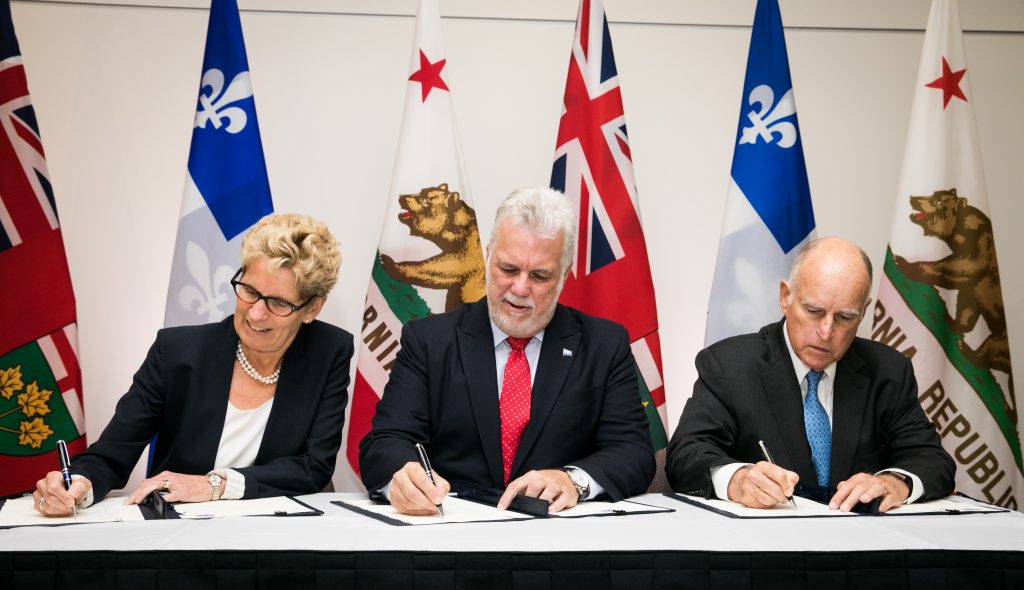It’s official. Ontario has now joined California and Quebec as a fellow “insurgent force” in the global fight against climate change. With Ontario formally entering the Québec-California cap-and-trade market in January 2018, we’ll be creating the largest carbon market in North America, – a model for international cooperation in reducing harmful greenhouse gas pollution.


How would a joint carbon market work?
Many of us are hazy on how cap-and-trade works in general, so let’s start with some context. Ontario has placed a cap on greenhouse gas emissions produced in the province, with the cap getting lower each year. Companies must obtain a permit or “allowance” for every ton of carbon they put into the atmosphere via an auction run by the province. The allowances can be then be traded between companies, allowing for the deepest emissions cuts at the lowest available cost. It’s an elegant, market-based solution to bring down polluting emissions.
Ontario’s system was crafted to eventually link up with our friends in the Quebec-California market, through the Western Climate Initiative, an independent group which administers the markets. Linking our carbon market means is that the three governments will plan and hold joint auctions of these GHG emission allowances starting in 2018, so that companies in California will be able to purchase allowances from companies in Ontario and vice versa. To facilitate this linkage, Ontario will have to set new caps on emissions for 2021-2030. Until now, we’ve know our reduction target of 37 per cent below 1990 levels by 2030, but not many specifics about how we’ll get there, so this will be a key process to watch in the coming months.


What are the pros and cons?
Access to a larger pool of allowances is expected to bring down the price of compliance for Ontario businesses, meaning fewer costs are passed down to consumers. Linkage will also bring more predictable rules and harmonized prices to the multi-state auctions, making it easier for companies to participate in the program. Joining together will create the largest carbon market in North America, covering a population of more than 60 million people and about $4 trillion in GDP.
However, some critics have pointed out that in a linked system, some companies will buy permits from California or Quebec rather than reduce emissions here in Ontario. This is where complementary policies and regulations to reduce emissions come into play, like the Ontario’s Climate Change Action Plan. By law, re-investments from Ontario’s cap-and-trade revenue must be directed into greenhouse gas reduction initiatives to meet our targets here at home, and this won’t change with the upcoming linkage. And hey – at the end of the day, the atmosphere doesn’t care much where polluting emissions are produced, just if there are fewer of them.
Why California and Quebec?
Ontario’s cap-and-trade market has been designed from the outset to align with systems in Quebec and California and allow for future linkage. With nearly identical emissions thresholds, sectors covered, and greenhouse gases included in the scope of the system, the transition is expected to be smooth. Because Quebec and California have solid climate targets cemented into law, we know that they will be strong partners in the fight against climate change. This is why linking with these jurisdictions is one the key steps identified in Ontario’s Climate Change Action Plan.
What can we expect to see in the future?
Although all three participating jurisdictions have had strong auctions recently, some minor market fluctuations are to be expected. We’ve seen carbon markets fluctuate in the past due to legal battles, political speculation, and other temporary external factors. These blips happen, but overall the WCI has proven to be a robust system. Since 2014, the Quebec-California market has sold roughly three quarters of its credits at auction and has gathered significant strength since California lawmakers voted to extend the state’s cap-and-trade program until 2030. Ultimately, if we’re successful in reducing carbon emissions, companies won’t need to buy as many allowances. So we must be very careful not to measure success based on sold-out auctions, and to view these fluctuations as normal.
We’ve seen incredible momentum recently in cap-and-trade markets, and in climate action in general. We need to join other climate leaders in addressing carbon emissions at a broader level, as well as ensure the ongoing stability and growth of Ontario’s cap-and-trade program, and its strategy to reduce greenhouse gas emissions.







